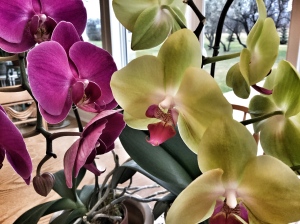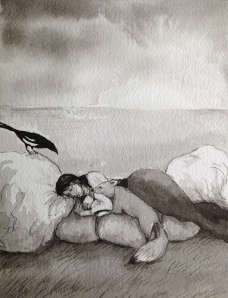I have recently evolved into a grower of orchids, an orchid enthusiast, if you will.
It was unintentional. I never meant to become this…um…type. In my mind I see a frigid, uptight figure hovering over precious specimens, lavishing them with obsessive attention that has no other outlet in her lonely life: The Crazy Orchid Lady.
I like to think I am not that person.
However, I must confess to putting pictures of fresh blooms on social media and gleefully pointing out new stems to visitors. My friends smile and nod politely. I am sure they are a bit puzzled by my enthusiasm. I expect there are a few eye rolls when I am out of range. (yes, I know it’s true)
No one could be more surprised by my sudden interest than me. What is it about growing orchids that delights me so? Is it their sexy appearance? The colourful show? The necessary fussiness?
The whole thing started after I received a couple of orchids (in bloom) as gifts. I had never owned an orchid before. I didn’t know what to do with them. Thank goodness I had my Mom to guide me. She told me to water them by placing the pot in a container of water rather than pouring it in from the top. She reminded me to dust the leaves. She provided me with a container of orchid fertilizer.
Aided by Mom’s sage advice, I kept the orchids alive. They graced my home with beauty for months. Placed strategically on tables in my living room, they looked lovely. I enjoyed their elegance until the exotic blooms started to fade. Eventually the last bloom drooped and fell.
I snipped off the long, arching, empty stems and took a good look at what I was left with.
The grocery store variety of orchid, phalaenopsis, without blooms is a rather hideous plant.
It looks like the tongues of dried out leather boots surrounded by petrified shoelaces.
Ugly. So ugly that once the blooms are gone, you do not want to leave the orchid in a place of prominence in your home. The homely little plant is banished, shoved into a lightless corner to collect dust. Special watering procedures are neglected. The scrawny green mess gets more dried out and petrified. Eventually the orchid is deemed dead and joins the Poinsettias, Chrysanthemums and Gerbera in the compost heap.
For some reason – perhaps it was because the orchids were gifts – I made an effort to keep them alive.
I dusted.
I watered.
I fertilized.
A couple of leatherish leaves grew. A few more tentacle-like roots crept forth; but the plant remained hideous.
A year went by.
Then one day, as I was performing my watering ritual, I noticed a short green stem poking out of leaf base. A week later – another! The stems grew long and divided into two, then three. Buds appeared, then gorgeous, vibrant blooms slowly opened. For some reason they seemed bigger, bolder and more beautiful than the original flowers. I gazed at them with delight. I had helped this horrid little plant become something more, something amazing.
I learned the key to success with orchids is that you must love them, even and especially when they are ugly.
So now, I am proud to provide. It costs me about 15 minutes of attention every month. I know I waste more time and energy on lesser things. My small efforts are rewarded generously. For a time, such as now, my home environment contains full-blown, extravagant gorgeousness.
I have the honour of witnessing beauty.
I am not a crazy orchid lady.
I am an orchid coach.
(Now, to apply the same approach to my family, creative practice, community………)












